Adaptation Finance Primer
The Adaptation Finance Primer
Adaptation finance is needed now more than ever. This Adaptation Finance Primer, co-developed with Climate Resilience for All, with funding from the ClimateWorks Foundation, presents potential sources of financing for climate adaptation and resilience projects as the world gets hotter, wetter, drier, and generally more vulnerable to the deadly and costly shocks and stresses of climate change.
We present an expansive vision of the landscape and levers of climate adaptation finance, including lesser known or emerging funding mechanisms like Disaster Risk Finance and Loss & Damage, and highlighting where we think the private sector could play a bigger role. Our goal is to empower practitioners to use the full spectrum of capital needed to reach people and communities most vulnerable to climate change.
Download the Adaptation Finance Primer or read highlights below.
What is adaptation finance?
We define adaptation finance as the financial flows that support adaptation and resilience activities, including activities that seek to prevent harm, to reduce or transfer risk, to recover from impacts, to compensate for loss and damage or to promote economic, social and natural ecosystems’ co-benefits, across all sectors.
In its broadest acceptance, adaptation finance includes a wide range of capital flows with both public and private capital in developing countries and industrialized economies. It ranges from multi-million dollars infrastructure projects, to homeowners hardening their homes against hurricanes, to a farmer switching crops in response to water scarcity.
It includes investments in new products or services, where demand will rise as communities and businesses invest in their own climate resilience. It also includes risk transfer mechanisms, the most important of which is insurance.
Philanthropic capital can play critical roles in adaptation to fund charitable A&R activities in vulnerable communities or to catalyze and de-risk other sources of capital.
Adaptation is underfunded globally (IPCC 2023, UNEP 2024). Adaptation finance is also poorly tracked outside of international public finance. Estimates for domestic public, philanthropic and private finance cited in this report are preliminary and may be undercounting existing flows.
Barriers to adaptation finance
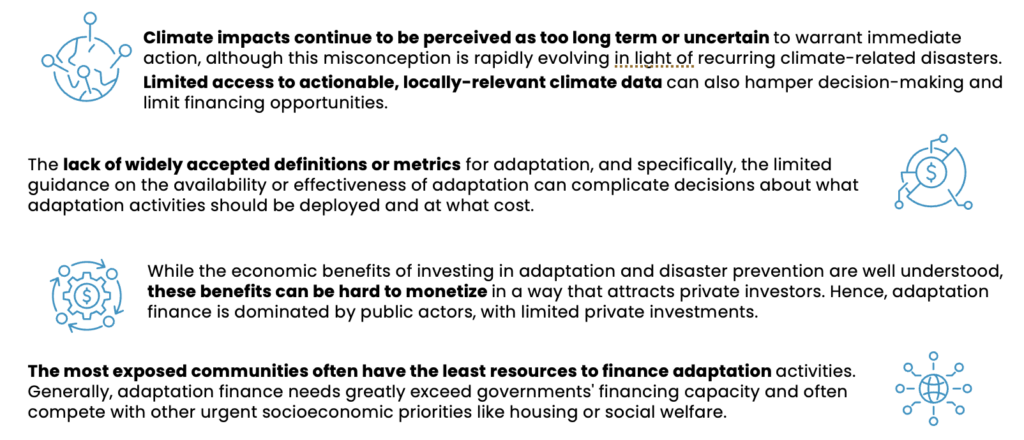
Our vision for the adaptation finance stack
Every community, institution, company, and government will need to consider how to combine different sources of capital together to fund and finance their own protection through adaptation interventions and projects that prevent and reduce the impacts of inevitable climate-driven disasters. We hope this Primer will accelerate the funding of adaptation projects in the face of increase climate threats.
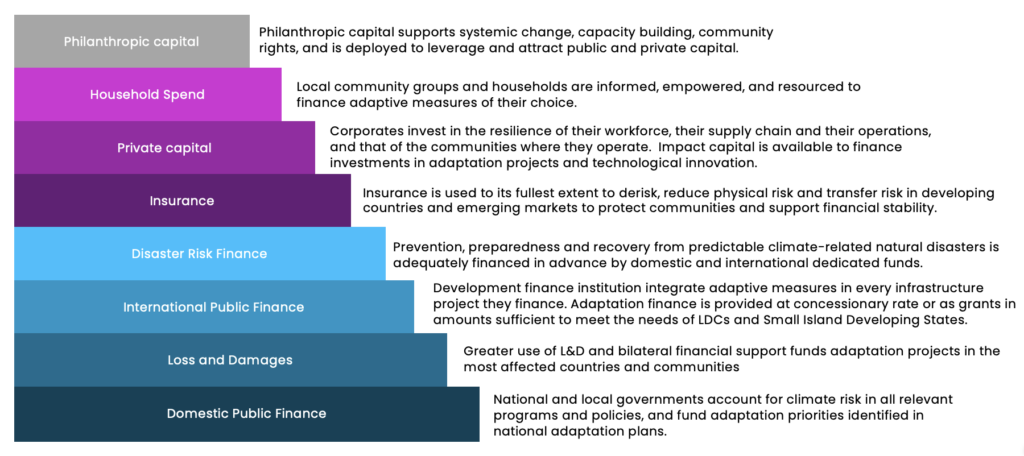
Case studies
Case Study #1: Extreme heat parametric insurance for informal women workers in India
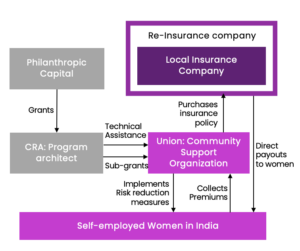
- Purpose: Women in the informal economy in India suffer severe health impacts from working in extreme heat or face economic hardship if they cannot work.
- Description: In partnership with SEWA, Climate Resilience for All’s parametric insurance program provides a supplement for income lost due to extreme heat. This parametric insurance product is automatically triggered when the temperature reaches a certain threshold. Women pay a portion of the premium to participate in the program, and the shortfall is covered by philanthropic grants. Risk reduction components such as Early Warning Systems and cooling centers are also deployed in parallel with the insurance product.
- Why Blended Finance: This program utilizes a well-established, efficient private sector instrument (insurance), but requires funding from philanthropies to supplement revenues from participants as they might not afford to buy the insurance if it were initially priced to reflect the full cost of the program.
- CRA’s parametric insurance program was developed in partnership with SEWA, the Self-Employed Women’s Association (SEWA). The insurance product was developed and is offered by Swiss Re.
Case Study 2: The Catalyst Fund, impact investments in African SMEs
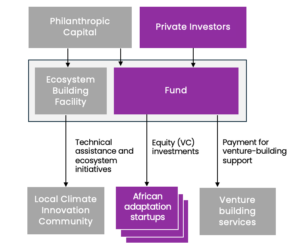
- Purpose: African startups capture only 1% of global finance flows and face critical gaps in funding, talent and access to knowledge. The fund helps build a pipeline of scalable adaptation solutions that are accessible, appropriate and affordable for vulnerable populations.
- Description: The Catalyst Fund is an early-stage fund that backs founders building climate adaptation and resilience solutions in Africa. It invests $200K in pre-seed startups and follows on subsequent rounds. The fund invests in fintech (including insurance), ag & food, water management, cold storage, waste management and health startups. The fund partners also provide hands-on support for founders to accelerate growth.
- Why blended finance? Funding from philanthropic capital enables investments in African startups that may otherwise seem too risky for private investors. It also funds technical assistance by way of an Ecosystem Building Facility.
- The Catalyst Fund is supported by FSD Africa, UK International Development, Cisco Foundation, the Global Environment Facility and is part of the Global Climate Finance Lab
Case study 3: TomorrowNow, localized weather data for smallholder farmers in Kenya
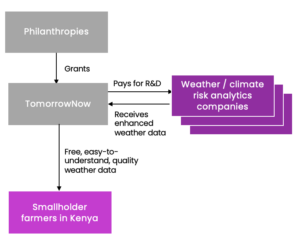
- Purpose: smallholder farmers in Africa lack access to quality weather data to help protect their crops from drought, heat and floods. Weather and climate data is generally poor in Africa due to a dearth of weather stations and a limited historical weather data set.
- Description: TomorrowNow is a non-profit spin off from Tomorrow.io, the weather analytics company. TomorrowNow pays advanced weather analytics and hardware companies like Tomorrow.io, Salient Predictions, Windborne and Arable to refine weather models in Africa and provide high-quality weather data, which is sent to 5M farmers in Kenya via SMS for timely weather crop advisory.
- Why blended finance? TomorrowNow receives philanthropic funding, which it uses to fund its operations and pay private companies for R&D and data that would not otherwise be commercially feasible for these companies due to a lack of bankable end-customer. TomorrowNow also uses funding to support local capacity building The model helps open access to higher quality data globally.
- TomorrowNow is supported by the Gates Foundation and NOAA.
Citations
This work should be cited as: Climate Resilience for All and Tailwind (2025). The Adaptation Finance Primer.
The Adaptation Finance Primer was funded by the ClimateWorks Foundation.